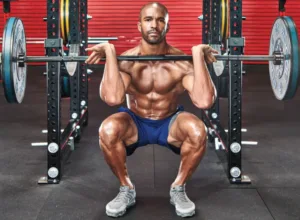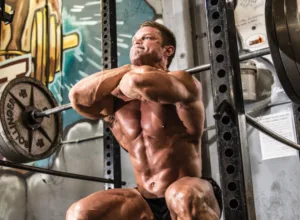A Front Squat is a strength exercise where a barbell rests on the front of the shoulders and upper chest, with the lifter holding a clean-grip position with elbows high. This compound movement emphasizes the quadriceps, glutes, and hamstrings, while also developing upper back strength and shoulder mobility. Proper form involves maintaining an upright torso, keeping the bar over the mid-foot, and driving the elbows forward and up throughout the movement.
Everybody squats – from fitness class newbies to bodybuilders, from park runners to Mo Farah – and part of the reason for that is there are dozens of ways to perform the exercise, with different variations better for different fitness levels.
But what unites all the variations is that they’re all terrific compound exercises. Squatting is a movement that works multiple muscle groups and joints at the same time. It’s incredibly efficient because it hits pretty much the whole lower body in one fell swoop. It works your glutes, quads, hamstrings, and calves hard, while also strengthening the smaller stabilizer muscles and the ligaments that support your main leg muscles.
Squats also increase the mobility in your ankles and hips, which – in combination with the strength benefits – can help to reduce your risk of injury when playing sports. And it’s not just the lower body that benefits from the squat: the move works your core too, and with so many large muscles involved you’ll find that rattling through a set of squats also gets your heart pumping, helping you to burn calories and improve your cardiovascular fitness.
No doubt hearing about all those benefits has left you raring to start squatting right away, so let’s dive straight in with the basic, unweighted squat. Once you’ve mastered that, read on for our favorite variations of the exercise, including several challenging weighted squats.
Vital Front Squat Grip Variations
The traditional back squats work your quads, hamstrings, and glutes while the front squats primarily target your quads. The front squats can be harder to perform as compared to the back squats. The front squats can put a lot of pressure on your lower back, wrists, and forearms.
If this wasn’t enough, there is always the possibility of the bar sliding forward while you perform a front squat. There are two variations of the front squat which can put varying degrees of pressure on your wrists and forearms.
The Weightlifter Grip
The weightlifter grip is also known as the full grip. A full grip involves holding the barbell with an overhand grip right outside shoulder-width. You need to keep your elbows pointed up so your upper arms are at least parallel to the floor.
The weightlifter’s grip requires mobility in your wrists, forearms, shoulders, and lower back, and is the harder of the two variations to perform. The full grip can help you keep the weights pinned to your shoulders so you can lift heavier weights.
The Bodybuilder Grip
The bodybuilder front squat grip involves holding the barbell with a crossed-arm grip. The crossed-arm grip is used by people who have limited mobility in their wrists and forearms. You can only hold the barbell in place with the bodybuilder front squat grip.
You can’t actively push the bar into your shoulders while you perform a front squat with this grip. It is even more important to keep your elbows pointed up with the bodybuilder’s grip as the chances of the bar sliding forward are significantly higher.
Check Out Our List Of The Best Supplements For Building Muscle, Shredding Muscle, Recovery, And Great Health, and Wellness Products! Purchase ifbnewsfeed.org‘s apparels Here: ifbnewsfeed.org

 Get Rid of Wrist Pain During Front Squats
Get Rid of Wrist Pain During Front Squats
If you use the weightlifter’s grip, you can encounter wrist and forearm pain while performing the squats. You will be in a better position if you perform a couple of warmup exercises and stretches for your wrists before going into the squats.
Extended Arm Wrist Stretches
The extended arm wrist stretches are the simplest warmups for the front squats. Extend your right arm with your palm facing the ceiling. Gently pull the fingers of your right arm towards your body with your left hand. Hold the stretch for 10-30 seconds.
Repeat the process with your left arm as the base arm. After you’re done with two sets of this exercise, point your palm towards the floor and repeat the stretching exercise. Doing this will warm up your upper and lower forearms.
Open Chest Stretches
The open chest stretching will help get your shoulders, chest, and wrists get warmed up for the front squats. Stand beside a squat rack with your arm extended and keep your elbow locked out.
Place your fingers on the squat rack and slowly start rotating away from the squat rack. After you’re done with the extended arm and open chest stretch, you’ll feel improved mobility in your wrists, forearms, and shoulders.
Avoid the Risk of the Bar Sliding Forward During Front Squats
Most people avoid performing the front squats because they can’t keep the bar steady on their shoulders. The bar sliding problem persists with both the weightlifter and bodybuilder grips. Before placing the bar on your shoulders, push your shoulders and arms forward so the bar can rest in the hole formed in the shoulder joints.
The best way to get rid of the bar sliding problem is to actively push your elbows upwards while you’re performing a front squat. Doing this will also help you keep your back straight which will put more tension on your quads.
At any point during the front squats, your elbows should not go below parallel to the floor. Looking at the roof while performing the squats can help you in keeping your elbows pointed up and your back straight.
Wrapping Up
A front squat is a compound exercise that involves squatting while holding a barbell across the front of your shoulders. This shifts the center of gravity and requires a more upright torso compared to a back squat. The technique is often used in Olympic weightlifting and CrossFit to improve core stability and leg strength.
More About Ideal Squat Depth Contents
- Here Is Everything You Need To Know About The King Of Strength Exercises: “The Back Squat”
- Learn On How To Improve Your “Squats Skills” And Perform It Properly
- The Best Way “To Front Squat” Without The Risk Of The Barbell Sliding
- The Side Affects Of Squatting: “The 5 Main Reasons” Why You Should Never Squat
- Quads Development: “Science Reveals Different Muscle Growth From Different Squat Depths”

- Get $200 With Your 1st Order Because Your Health Matters
- Best Supplements For Muscle Building, Strength & Champion Performance
- Best Supplements For Intense Energy, Performance & Endurance







